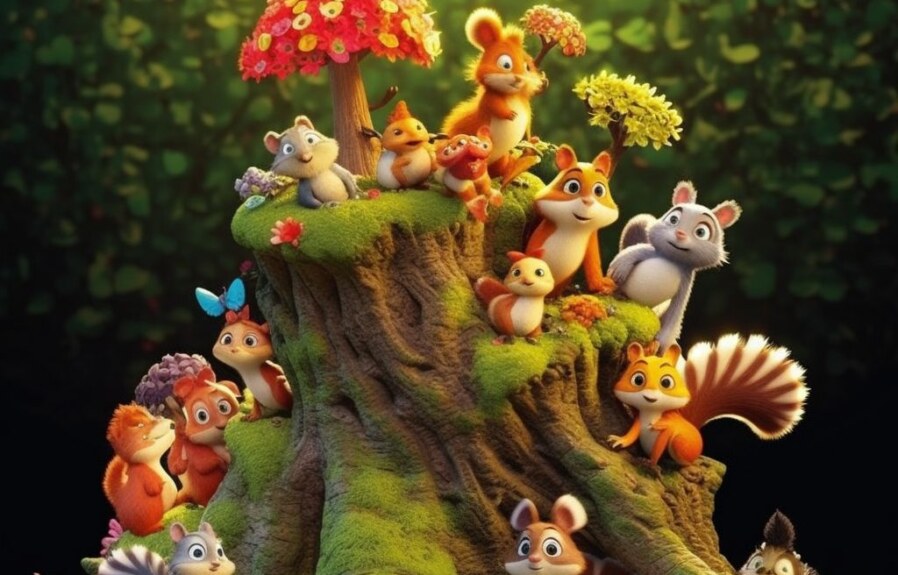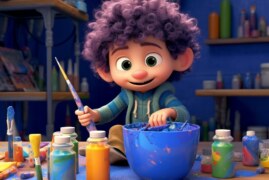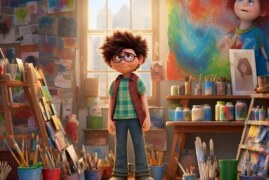Maroon is a rich, deep hue that exudes elegance and sophistication, making it a popular choice in both fashion and home décor. However, achieving the perfect shade of maroon can be a daunting task, especially for those who are not well-versed in the color wheel and color theory. Fear not, for in this article, we will guide you through the process of making maroon from scratch, using a variety of mediums, including paint, dye, and fabric. From the basic principles of color mixing to the science behind complementary colors, we will explore all the essential factors that come into play when creating this timeless color. So, grab your brushes and let’s dive into the world of maroon making!
1. Introduction: Understanding the Color Maroon
Maroon is a deep and rich reddish-brown color that has been a popular choice in art and design for centuries. This hue is often associated with luxury, elegance, and sophistication. It is a color that has been used in paintings, fashion, interiors, furniture, and even in branding and advertising. To make maroon, a proper understanding of color theory and color mixing techniques is required.
In the world of art and design, color theory is a fundamental concept that helps artists and designers to create visually appealing compositions. The color wheel is one of the most basic tools in color theory that explains how colors work together. The primary colors of the color wheel are red, blue, and yellow, and they are the building blocks for all other hues.
To make maroon, you need to use a combination of primary colors, secondary colors or complimentary colors, depending on the desired shade. This article will explore various techniques for color mixing and how to achieve the perfect maroon hue in your art and design projects.
2. The Basic Color Theory: How Colors Mix
Understanding how colors mix is crucial to creating the perfect shade of maroon. In color theory, there are three basic colors: red, blue, and yellow. These colors are known as primary colors because they cannot be created by mixing any other colors together. Instead, other colors are created by mixing different combinations of primary colors together.
When two primary colors are mixed together, you get a secondary color. For example, when blue and yellow are mixed together, they create green. The secondary colors are green, purple, and orange. These colors are known as secondary colors because they are made by combining two primary colors.
To create maroon, you will need to mix red and blue together. Start by mixing small amounts of each color together until you get the desired shade of maroon. Remember that adding too much of one color over the other can result in a different shade altogether. For instance, adding too much blue to the mix could result in a shade closer to purple than true maroon.
It is important to note that different types of paint (such as oil-based or water-based) can mix differently. Experiment with different types of paint and mixing techniques to find the perfect maroon for your project.
By understanding the basic color theory and mixing techniques, you can create a perfect shade of maroon for your art or design projects. Keep experimenting and have fun with mixing colors!
3. Creating Maroon with Primary Colors: Red, Blue and Yellow
Maroon, a beautiful deep red color, can be made by mixing primary colors in specific ratios. Look for a tube of red, blue, and yellow paint, or any medium that provides good color mixing capabilities. In this section, we will guide you through the process of creating your perfect shade of maroon.
Step 1: Understanding the Basic Color Theory
Before diving into the mixing process, it’s essential to understand the basic color theory. Colors are classified as primary, secondary, or tertiary. Red, blue, and yellow are considered primary colors as they cannot be created by mixing other colors. Secondary colors are obtained by mixing two primary colors, while tertiary colors are obtained by mixing a primary and a secondary color.
Step 2: Mixing the Primary Colors
To create maroon, mix one part red and one part blue to create purple. Next, add a small amount of yellow to the purple until you achieve your desired shade of maroon. Keep in mind that the exact ratio of each color needed for your perfect maroon shade might vary based on various factors like paint brand, lighting, and other environmental factors.
Step 3: Experiment with Ratios
Don’t be afraid to experiment with different ratios of red, blue, and yellow until you find the exact shade of maroon you desire. The beauty of this color mixing process is that it’s entirely customizable to your preferences.
To conclude, creating maroon with primary colors like red, blue, and yellow is a great way to achieve your desired shade of this beautiful color. By following the basic color theory and experimenting with different color ratios, you can create maroon that perfectly complements any design or artwork.
4. Mixing Maroon with Secondary Colors: Purple and Orange
Mixing secondary colors can give us a different range of maroon hues. These colors are formed by combining two primary colors in equal proportions. Here are some ways to make maroon using secondary colors:
1. Mixing with Purple:
To make maroon with purple, you need to mix a red shade with a blue shade of purple. Start by mixing equal parts of blue and red. Then gradually add more red to increase the intensity of the color. Keep adjusting until you achieve the perfect maroon hue.
2. Mixing with Orange:
Creating maroon with orange requires you to mix equal parts of red and orange. The result is a warm, rich maroon color. You can also adjust the tint by using more or less of one color.
Keep in mind that the hue will differ depending on the shades of purple or orange you use, and how much of each you mix. Secondary colors are a great way to experiment and get different variations of maroon.
Try combining these colors in different ratios to develop unique maroon shades that work best for your projects. Remember to experiment and have fun with the process.
5. Using Complimentary Colors to Make Maroon: Green and Red
5. Using Complementary Colors to Make Maroon: Green and Red
Complementary colors are colors that are opposite to each other on the color wheel. When used together, they create a dynamic and eye-catching effect. One way to achieve the color maroon is to mix its complementary colors – green and red.
Mixing Green and Red:
To make maroon using green and red, you will need equal parts of each color. Start by mixing a small amount of green with red, until you achieve a shade that is close to maroon. You may find that you need to adjust the ratio of green to red depending on the specific shades of your colors.
It’s important to note that when mixing complementary colors, the colors tend to cancel each other out, often creating a dull or muted hue. To avoid this, try using a more vibrant shade of green or a deeper shade of red to start with.
Using Green and Red in Design Projects:
Green and red are perfect for creating designs with a festive or seasonal feel, such as Christmas or St. Patrick’s Day. This color combination can also be used for logos, branding, and packaging designs, adding a sense of boldness and energy to the overall look.
Keep in mind that maroon created with green and red will have a slightly different tone than maroon created with primary or secondary colors. Experiment with different ratios and shades to find the perfect maroon hue for your art or design project.
6. Using Print Techniques to Achieve Maroon: CMYK vs RGB
When it comes to printing, achieving the perfect maroon hue can be a bit tricky. This is because there are two different color modes used in printing: CMYK and RGB. Understanding the difference between the two and knowing how to use them to your advantage can help you create the desired shade of maroon for your art and design projects.
CMYK:
CMYK stands for Cyan, Magenta, Yellow, and Key (or Black). It is a subtractive color model used in printing. With this technique, colors are created by overlapping dots of ink on paper. By mixing different percentages of cyan, magenta, yellow, and black, you can achieve a wide range of colors, including maroon.
When using CMYK to create maroon, the ideal mix is 25% cyan, 100% magenta, 75% yellow, and 40% black. This mix will result in a rich, deep maroon hue that is perfect for printing.
RGB:
RGB stands for Red, Green, and Blue. It is an additive color model used in digital media, such as on computer screens and televisions. With this technique, colors are created by adding different amounts of light together. By mixing different percentages of red, green, and blue, you can achieve a wide range of colors, including maroon.
When using RGB to create maroon, the ideal mix is 128 red, 0 green, and 0 blue. This mix will result in a rich, deep maroon hue that is perfect for digital media.
Keep in mind that colors often look different on a computer screen than they do in print. It’s important to test your colors in both CMYK and RGB modes and adjust as needed to achieve the perfect maroon hue for your project.
7. Tips for Achieving the Perfect Maroon Hue in Art and Design Projects
Achieving the perfect maroon hue can be a tricky task, but there are certain tips and techniques that can make the process easier. Here are some of our top recommendations for making maroon stand out in your art and design projects.
Use a Darker Red as Your Base
When mixing colors to make maroon, it can be tempting to start with a bright, vibrant red. However, in order to achieve the right depth and richness for maroon, it’s important to use a darker red as your base. Look for shades like burgundy, cherry, or brick red to provide a solid foundation for your mixture.
Build Your Hue Gradually
Creating maroon is a process, and it’s important to build your hue gradually as you mix in other colors. Don’t be too hasty in adding in shades of blue or purple – take small steps and mix thoroughly to ensure that you’re happy with each stage of the process.
Experiment with Color Ratios
There’s no one “correct” way to make maroon, as the exact hue will depend on the specific colors you use and the ratios you mix them in. Play around with different proportions of red, blue, and yellow, as well as secondary colors like purple and orange, to see which combinations work best for your project.
Consider the Final Use of Your Creation
Finally, it’s important to consider the final use of your maroon creation before settling on your perfect hue. Printed materials like posters and flyers may require a different hue than a painting or digital design. Keep in mind the medium in which your project will be viewed, and adjust your maroon mixture accordingly.
People Also Ask
What colors make maroon?
Mixing red and brown in varying proportions gives the shade of maroon. Generally, three parts of red with one part of brown produce the desired hue.
How do you make dark maroon?
Start by mixing equal parts of red and blue together to make purple. Then, add a small amount of orange to the mix to create maroon. Add more red or blue as necessary to adjust the darkness.
What two colors make burgundy?
Burgundy is a shade of red that is created by mixing equal parts of red and blue. It is a deep, rich color that is often used in clothing, furniture, and home decor.
What is the difference between maroon and burgundy?
Maroon is a dark brownish-red color, whereas burgundy is a purplish-red color. Maroon is warmer compared to burgundy, which is cooler in tone. The two colors can be used together to create a beautiful color palette.
What can I use instead of maroon?
If you do not have maroon, you can use a combination of red and brown to create the color. You can create a variety of shades by adjusting the amount of each color you use. Other colors that you could use instead of maroon include burgundy or dark red.
Conclusion
Maroon is a rich and warm color that can be made by mixing red and brown in varying proportions. By adjusting the amount of each color, you can create different shades and variations of maroon. Burgundy is a similar shade to maroon, while red and brown can be used as substitutes. With these color combinations, you can create beautiful color palettes and bring depth and warmth to your designs.



